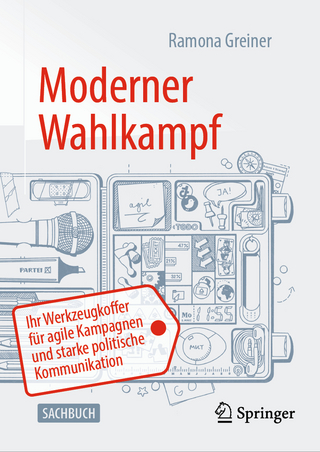
Quantitative Research Methods for Communication
Oxford University Press Inc (Verlag)
978-0-19-086106-3 (ISBN)
Jason S. Wrench is Assistant Professor in the Department of Communication and Media at the State University of New York at New Paltz. Candice Thomas-Maddox is Regional Coordinator and Associate Professor of Communication Studies at Ohio University Lancaster. Virginia Peck Richmond is Professor and Chair of the Communication Studies Department at the University of Alabama at Birmingham and Professor of Communication Studies (Emerita) at West Virginia University. James C. McCroskey was Scholar in Residence in the College of Arts and Humanities at the University of Alabama at Birmingham and Professor of Communication Studies (Emeritus) at West Virginia University.
BRIEF CONTENTS
Preface
CHAPTER 1 An Introduction to Communication Research
CHAPTER 2 Empirical Research
CHAPTER 3 Research Ethics
CHAPTER 4 Searching for Previous Research and American Psychological Association Style
CHAPTER 5 Research Structure and Literature Reviews
CHAPTER 6 Variables
CHAPTER 7 Measurement
CHAPTER 8 Reliability and Validity
CHAPTER 9 Survey Research
CHAPTER 10 Content Analysis
CHAPTER 11 Experimental Design
CHAPTER 12 Sampling Methods
CHAPTER 13 Hypothesis Testing
CHAPTER 14 Descriptive Statistics
CHAPTER 15 Chi-Square (?2) Test of Independence
CHAPTER 16 Independent Samples t Tests
CHAPTER 17 One-Way Analysis of Variance
CHAPTER 18 Correlation
CHAPTER 19 Regression
CHAPTER 20 Presenting Research
Appendix A Qualitative Research (Available online https://oup-arc.com/wrench)
Appendix B Textbook Questionnaire (Available online: https://oup-arc.com/wrench)
Appendix C Open-Source Statistical Software Alternatives (Available online: https://oup-arc.com/wrench)
Appendix D Big Data (Available online: https://oup-arc.com/wrench)
Appendix E Advanced Statistical Procedures (Available online: https://oup-arc.com/wrench)
Glossary
Index
CONTENTS
Preface
CHAPTER 1 An Introduction to Communication Research
The History of the Social Sciences
The Nature of Communication
Understanding the Book's Format
Research Outside the Walls of Academia
Conclusion
CHAPTER 2 Empirical Research
Ways of Knowing
Epistemology
Ordinary Versus Scientific Ways of Knowing
The Scientific Approach to Communication Research
Scientific Method
Theories
Describe the National Phenomenon
Predict the Future
Falsification
Predictions/Hypotheses
Observations
Empirical Generalizations
Conclusion
Research Outside the Walls of Academia
CHAPTER 3 Research Ethics
Defining Ethics
Good Means-Good End: Ethical Behavior
Bad Means-Bad End: Unethical Behavior
Bad Means-Good End: Machiavellian Ethic
Good Means-Bad End: Subjective Ethic
The Belmont Report's Effect on Research Ethics
Informed Consent
Principle of Beneficence
Justice
Institutional Review Boards
Institutional Review Board Basics
Informed Consent
Institutional Review Board Processes
Basic Institutional Review Board Functions
Full-Board Review
Specific Ethical Issues for Research
Data Accuracy
Data Sharing
Duplicate Data Publication
Post Hoc Hypothesis Revision
Participant Identity Disclosures
Authorship Credit
Conflicts of Interest
Plagiarism
Source-Not-Cited Types of Plagiarism
Source-Cited Types of Plagiarism
Ethical Research Outside Academia
Conclusion
CHAPTER 4 Searching for Previous Research and American Psychological
Association Style
Step 1: Identifying the Topic
Step 2: Clarifying the Research Question and Generating Key Terms
Stating The Topic In The Form of a Research Question
Identifying Key Terms and Synonymous Terms
Step 3: Locating Sources of Information
Types of Information Sources
Locating Information Sources
Handbooks and Subject Encyclopedias
Electronic Databases
The World Wide Web
Evaluating Web Sources
Step 4: Organizing and Evaluating Information
Step 5: Citing Sources of Information Using the APA Format
What Information Must Be Referenced?
Citing Sources of Information
Parenthetical Citations
Quotations and Paraphrases
APA Paper Formatting
Creating a Title Page
Creating an Abstract
Creating the First Page
Creating the Reference Page
Conclusion
CHAPTER 5 Research Structure and Literature Reviews
The Abstract
The Introduction
Attention-Getter
Using Statistics or Claims
Posing a Rhetorical Question
Using an Acknowledged Fact
Using a Story or Illustration
Quoting or Acknowledging a Source
Link To Topic
Significance of Topic
Espousal of Credibility
Thesis and Preview
Literature Review
Five Reasons for Literature Reviews
Previous Research
Chronological
Cause and Effect
Compare and Contrast
Problem-Cause-Solution
Psychological
Categorical/Topical
General to Specific
Specific to General
Known to Unknown
Study Rationale
Method Section
Participants
Apparatus
Procedure
Instrumentation
Results Section
Discussion Section
The Conclusion
Research Outside the Walls of Academia
Reading and Critiquing Academic Literature
Preparing a First Draft
Step 1: Identify Your General Topic
Step 2: Determine The Type of Study You Are Conducting
Step 3: Determine What Variables You Will Examine
Step 4: Search for Primary Sources
Step 5: Obtain Full Text References
Step 6: Look for Other References in Obtained Materials
Step 7: Narrow Your List of References
Step 8: Organize References by Major and Subtopics
Step 9: Look for Gaps in Your References
Step 10: Find References to Fill Gaps
Step 11: Create a Literature Review Outline
Step 12: Write
Conclusion
CHAPTER 6 Variables
How Are Research Projects Developed?
Variables: Units of Analysis
Units of Analysis
Aspects of Variables
Variable Attributes
Variable Values
Understanding Relationships and Differences
Relationships
Differences
Types of Variables
Variable Levels
Nominal Variables
Ordinal Variables
Interval Variables
Likert
Semantic Differential
Staple's Scalogram
Ratio Variables
Communication Variables
Nominal Variables
Ordinal Variables
Interval Variables
Common Interval Variable Measures
Communication Apprehension
Ethnocentrism
Humor Assessment
Nonverbal Immediacy
Sociocommunicative Orientation
Willingness to Communicate
Beliefs and Attitudes
Ratio Variables
Writing Up Scales Using APA Style
Participants
Procedures
Instrumentation
Conclusion
CHAPTER 7 Measurement
Numbers and Things
Review of Measurement Levels
Nominal
Ordinal
Interval
Ratio
A History of Measurement
Likert Scales
Semantic Differential
Measuring Communication
Personality Traits/States
Beliefs and Attitudes
Knowledge
Developing Your Operationalization
Conceptualization
Operationalization
Constructing Questions
One Measure, Multiple Factors
Measurement and Statistical Analysis
Research Outside the Walls of Academia
Conclusion
CHAPTER 8 Reliability and Validity
Reliability
Scalar Reliability
Test-Retest Reliability
Alternate Forms Reliability
Split-Half Reliability
Cronbach's Alpha Reliability
Computer Printouts of Cronbach's Alpha
SPSS and Cronbach's Alpha APA Discussion
Alpha Reliabilities From This Book
Reliabilities In The Real World
Improving Reliability of Measurement
Validity
Face or Content Validity
Criterion Validity
Predictive
Concurrent
Retrospective
Construct or Factorial Validity
Validity Threats
Problems with Measurement
Research Outside the Walls of Academia
Conclusion
CHAPTER 9 Survey Research
When to Use a Survey
Do You Know What You Want To Ask?
Do You Really Need To Collect New Data?
Do Your Participants Know Anything or Will They Even Tell You?
Is Your Goal Generalizability?
How to Conduct Survey Research
Step 1: Picking Your Questions
Nominal Level Questions
Ordinal Level Questions
Interval Level Questions
Ratio Level Questions
Open-Ended Questions
Step 2: Creating Clear Instructions
Step 3: Study Design
Step 4: Data Processing and Analysis
Step 5: Pilot Testing
Use Actual Survey Population Members
Anticipate Survey Context
Test Parts of the Survey
Determining a Pilot Sample Size
Ask Questions after Someone Completes the Survey
Disseminating Your Surveys
Interviewing
Face-to-Face Interviewing
Telephone Interviewing
Self-Administration
Mass Administration
Mailed Administration
Internet Administration
Advantages and Disadvantages of Self-Administered Surveying
Problem Areas Associated with Survey Research
Response Rate
Unit Nonresponse
Item Nonresponse
Effects of Nonresponse
Improving Response Rates
Translating Surveys into Other Languages
Semantic Equivalence
Conceptual Equivalence
Normative Equivalence
Simple Direct Translation
Modified Direct Translation
Translation/Backtranslation
Parallel Blind Technique
Random Probe
Using the Research Project Worksheet
Question
Design
Setting Participants
Specific Characteristics
Recruitment
Consent
Variables
Independent Variables
Dependent Variables
Hypotheses/Research Questions
Statistical Testing
Tentative Study Title
Principal Researcher(s)
Measurement Outside of Academia
Conclusion
CHAPTER 10 Content Analysis
Conducting a Content Analysis
Theory and Rationale
Conceptualization
Operationalization
Coding Schemes
Sampling
Training and Pilot Reliability
Introduction to Coding Book
Sample Coding
Coding of Initial Data
Initial Reliability
APA Write-Up
Retraining
Final Coding
Final Reliability
Tabulation And Reporting
Conclusion
CHAPTER 11 Experimental Design
What Are Experiments and Why Do We Do Them?
Rationale For Experimental Research
Aspects Of Experimental Design
Random Assignment
Manipulation of the Independent Variable
Measurement of the Dependent Variable
Controlling an Experiment
Conducting an Experiment
Introducing the Experiment and Obtaining Consent
Random Assignment
Manipulate the Independent Variable
Measure the Dependent Variable
Debriefing
Threats to Experimental Validity
Historical Flaw
Maturation
Testing Flaw
Regression To The Mean
Selection Threat
Attrition
Common Experimental Designs
Preexperimental Designs
One-Shot Case Study
One-Group Pretest Posttest Design
Static Group Comparisons
Quasi-Experimental Designs
Pretest-Posttest Design
Time Series
Multiple Time Series
Switching Replications Design
True Experimental Designs
Pretest-Posttest Design
Two-Group Posttest-Only Design
Randomized Switching Replications
Design
Solomon Four-Group Design
Final Thoughts on Experiments
Conclusion
CHAPTER 12 Sampling Methods
Why Use a Sample?
Population
Sample
The Sampling Process
Selecting a Sample Design
Probability Sampling
Simple Random Samples
Stratified Random Samples
Cluster Samples
Systematic Samples
Sampling Error
Nonprobability Samples
Convenience Samples
Volunteer Samples
Purposive Samples
Quota Samples
Network Sample
Determining Sample Size
Common Sense Sample Recruiting
Ethical Recruitment
Conclusion
CHAPTER 13 Hypothesis Testing
Hypotheses
One-Tailed Hypotheses
Two-Tailed Hypotheses
Research Questions
Directional Research Questions
Nondirectional Research Questions
Alternative and Null Hypotheses
Hypothesis Testing Case Study
Hypothesis Testing in the Case Study
From Random Samples to a Whole Population
Testing for Significance
Step 1: Set the Probability Level
Step 2: Conduct a Statistical Test
Step 3: Comparing Calculated and Critical Values
Testing for Power
Effect Sizes
Understanding Error
The Confidence Interval
Power Type I Error
Type II Error
Conclusion
CHAPTER 14 Descriptive Statistics
The Benefits of Statistics
Descriptive Versus Inferential Statistics
Measures of Central Tendency
Mean
Median
Mode
Frequency Distributions
SPSS and Frequency Distributions
Frequency Distributions and Charts
Skewness and Kurtosis
Measures of Variability
Range
Sum of Squares
Variance
Standard Deviation
Dataset Variability
Conclusion
CHAPTER 15 Chi-Square (?2) Test of Independence
Case Study Introduction
Chi-Square Background Information
Step-by-Step Approach to the Chi-Square Test of Independence
Computer Printouts of the Chi-Square Test of Independence
SPSS and Chi-Squares
APA Write-Up Discussion of Findings
Post Hoc APA Write-Up
Biological Sex and Book Edition
APA Write-Up
Discussion of Brummans and Miller's Article
Article Purpose
Methodology
Results
Chi-Squares Outside Academia
Conclusion
CHAPTER 16 Independent Samples t Tests
Case Study Introduction
Independent Samples t Test Background Information
Step-by-Step Approach to the Independent t Test
Computer Printouts of the Independent t Test
SPSS and t Tests
APA Write-Up (SPSS) Discussion of Findings
Biological Sex and Communication Apprehension
APA Write-Up (SPSS) Discussion
Calculating Effect Sizes
Discussion of the Weber, Fornash, Corrigan, and Neupauer Article
Article Purpose
Methodology
Results
Paired t Tests
t Tests Outside Academia
Conclusion
CHAPTER 17 One-Way Analysis of Variance
Case Study Introduction
One-Way ANOVA Background Information
Step-by-Step Approach to the One-Way ANOVA
Computer Printouts of the One-Way ANOVA
SPSS and One-Way ANOVAs
Multiple Comparison Tests
APA Write-Up (Without Chart)
APA Write-Up (With Chart)
Discussion of Findings
Political Affiliation and Humor Assessment
APA Write-Up
Discussion
Discussion of the Boiarsky et al. Article
Article Purpose
Methodology
Results
One-way ANOVAs Outside Academia
Conclusion
CHAPTER 18 Correlation
Correlation Background Information
Types of Relationships
Correlation Not Causation
Correlation Assumptions
Case Study Introduction
Step-by-Step Approach to the Pearson Product-Moment Correlation
Computer Printouts of the Pearson Product-Moment Correlation
SPSS and Pearson Product-Moment Correlations
APA Write-Up
Discussion
Relationships among CA, WTC, and Beliefs about Public Speaking
APA Write-Up
A Note About R
Reading Large Correlation Tables
Discussion of the Chesebro Article
Article Purpose
Methodology
Results
Discussion of the Punyanunt Article
Article Purpose
Methodology
Results
Correlations Outside Academia
Conclusion
CHAPTER 19 Regression
Case Study Introduction
Regression Background Information
Step-by-Step Approach to a Linear Regression
Computer Printouts of the Linear Regression
SPSS and Simple Linear Regressions
APA Write-Up
Discussion
Relationships between CA and Beliefs about Public Speaking
APA Write-Up
Understanding Multiple Linear Regressions
APA Write-Up
Discussion
Discussion of the Wrench and Booth-Butterfield Article
Article Purpose
Methodology
Results
Discussion of the Rocca and Vogl-Bauer Article
Article Purpose
Methodology
Results
Regressions Outside Academia
Conclusion
CHAPTER 20 Presenting Research
Writing a Discussion Section
Providing a Summary of Major Findings
Providing an Interpretation of Findings
Discussing the Relationship Between Findings and Previous Studies
Acknowledging Limitations
Discussing Implications and Future Directions
Writing the Abstract
Presenting at Conferences
Divisions and Interest Groups
Submitting Research For Conference Review
Types of Conference Presentations
Paper Presentations
Poster Presentations
Scholar-to-Scholar Posters
Panel Discussions
Publication
Journal Review Process
Submission Process
Review Process
Research Outside the Walls of Academia
Writing For Business
Research and The General Public
Writing Statistical Stories
Infographics
Conclusion
Appendix A Qualitative Research (Available online: https://oup-arc.com/wrench)
Appendix B Textbook Questionnaire (Available online: https://oup-arc.com/wrench)
Appendix C Open-Source Statistical Software Alternatives (Available online: https://oup-arc.com/wrench)
Appendix D Big Data (Available online: https://oup-arc.com/wrench)
Appendix E Advanced Statistical Procedures (Available online: https://oup-arc.com/wrench)
Glossary
Index
| Erscheinungsdatum | 12.01.2019 |
|---|---|
| Verlagsort | New York |
| Sprache | englisch |
| Maße | 251 x 203 mm |
| Gewicht | 1610 g |
| Themenwelt | Naturwissenschaften |
| Sozialwissenschaften ► Kommunikation / Medien ► Kommunikationswissenschaft | |
| Sozialwissenschaften ► Kommunikation / Medien ► Medienwissenschaft | |
| ISBN-10 | 0-19-086106-1 / 0190861061 |
| ISBN-13 | 978-0-19-086106-3 / 9780190861063 |
| Zustand | Neuware |
| Haben Sie eine Frage zum Produkt? |
aus dem Bereich


